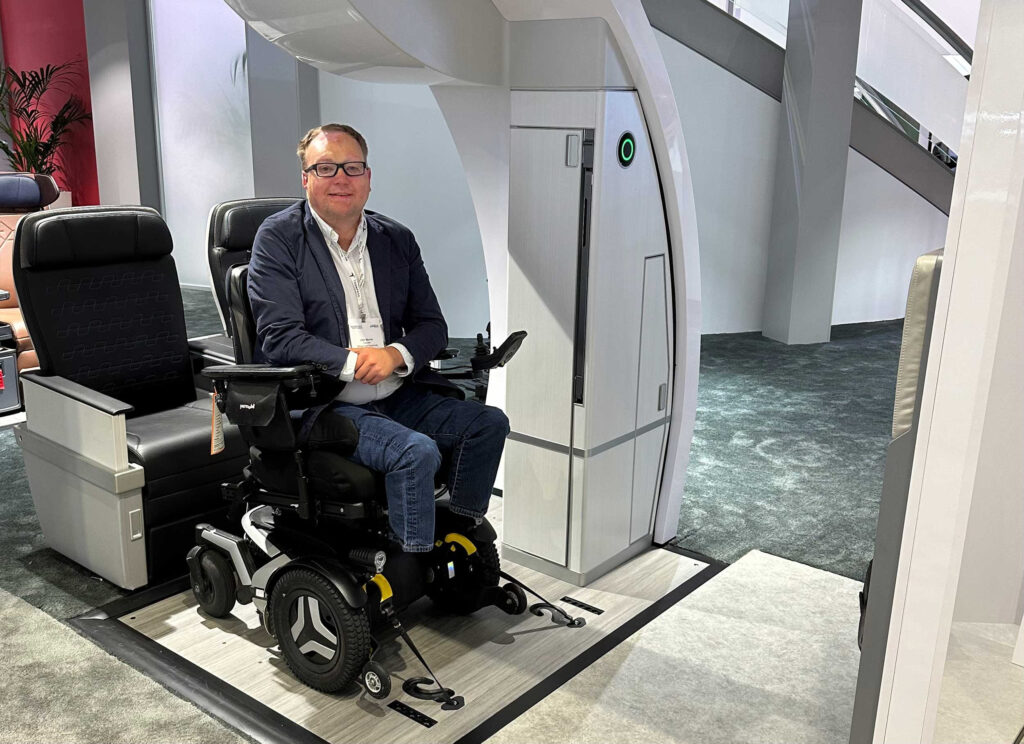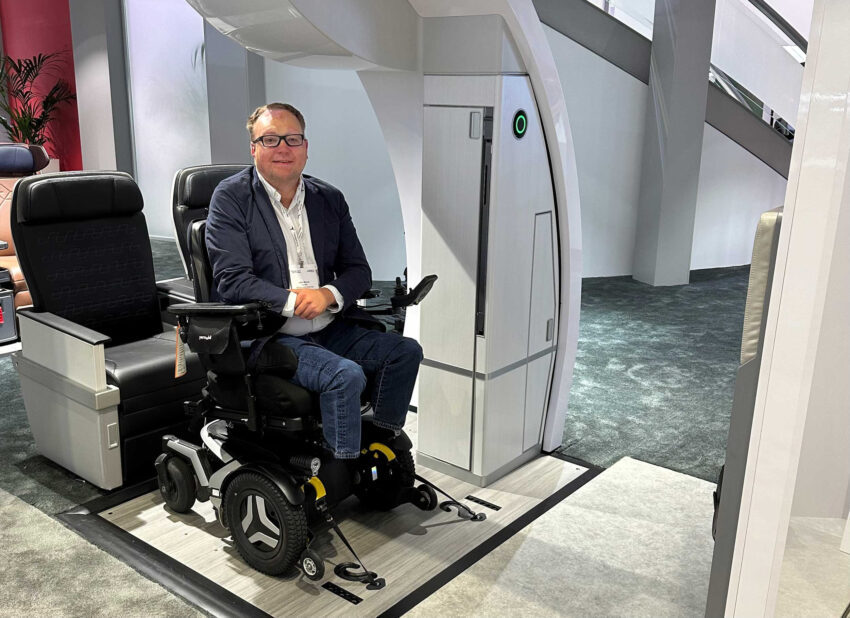Written by John Morris, WheelchairTravel.org, May 31, 2024
Debut of second wheelchair securement space concept in Hamburg kicks off dramatic race to certification and installation in the aircraft cabin.
Then there were two.

Two major players in aviation focused on developing a solution to make space for manual and powered wheelchairs in the aircraft cabin.
Enter Collins Aerospace, one of the world’s largest aircraft cabin interiors manufacturers and a subsidiary of RTX Corporation, who have joined Delta Flight Products in unveiling a wheelchair securement prototype for commercial airplanes.
At the Aircraft Interiors Expo in Hamburg, Germany this week, I demoed Collins’ onboard mobility solution, which was displayed within a Boeing 737 aircraft mock-up. Here is a video, wherein I describe the prototype, roll through the boarding door and reverse into the securement space:
The Collins prototype is unique in that, for many airframes and LOPAs (layouts of passenger accommodations) it may require no changes to the existing seating configuration, instead reclaiming space in the aircraft cabin currently dedicated to a closet and/or bulkhead wall.
(This raises an interesting question about Air Carrier Access Act requirements — Would the USDOT eliminate the requirement for a wheelchair storage closet if a wheelchair securement space is available?)

Earlier illustrations of this seating system, shared by Collins in 2022, saw the wheelchair user enclosed within a modified storage closet. I was not a fan.

The new mobility solution eliminates the closet, but still sees the wheelchair user secured in front of a first class/premium economy seat. The securement system, like the one previewed by Delta Flight Products, is recessed into the cabin floor. Although the prototype displayed in Hamburg featured linoleum flooring, production models would be designed to match the airline client’s interior design.
Collins’ solution may maximize range of movement (tilt/recline) for power wheelchair us
By placing the wheelchair securement space in a nontraditional seating location, the wheelchair user could in theory be given a high degree of freedom in adjusting a power wheelchair to their level of comfort. Tilt and recline features would not be restricted by adjacent seats or fixtures and, if freedom of movement were permitted, pressure relief would no longer be a concern for disabled passengers.
Some questions have been raised about what limits the FAA might place on use of a wheelchair’s functions onboard the aircraft. Would power wheelchair seating systems require a manual adjustment capability, as lay flat business class seats require, in order to return the wheelchair upright for takeoff and landing in the event of a failure? Would wheelchairs be required to be fully upright during these phases of flight? Many questions are being raised and will require guidance from regulators.
Partial, rather than full integration of the wheelchair user into the aircraft cabin
Unlike other proposals for wheelchair securement spaces, the Collins solution sets wheelchair users apart from other passengers, their companions and caregivers.
Advocates have long prioritized bringing a wheelchair space into the airplane cabin, as doing so would open the world to millions of disabled people who could not otherwise fly. But for those travelers with the most complex medical and care needs, it is important to consider how cabin design impacts their comfort, safety and security, and whether a more complete integration is necessary.
Regardless of the ultimate solutions adopted by airlines and regulated by governments, it is exciting that we have now reached beyond questions of possibility and into debates over the practicality of various solutions and cabin arrangements. Airlines are now asking where it is best to install a wheelchair securement product.
On narrowbody airframes, carriers would likely be limited to a single wheelchair securement space with the Collins solution
Two monuments are typically located behind the boarding door on single-aisle aircraft — on the left side, a storage closet and on the right, a galley fixture. Removing the closet is simple enough and is a minor adjustment to the cabin layout, whereas removing galley space would lead to downstream challenges for air carriers.
Although carriers may think that one wheelchair securement space is enough, the disability community is sure to advocate for two — disabled people travel together and, even in the case of solo travelers like myself, I have often seen other wheelchair users traveling on my same flight.
In the United States, other modes of transit like buses and trains require space for two wheelchairs. In the 2024 FAA Reauthorization signed into law by the president, the U.S. Secretary of Transportation was given the directive, pending a study on the economic feasibility of wheelchair securement spaces, to conduct a negotiated rulemaking in which a minimum of two such spaces would be required per aircraft.
Wheelchair Travel Newsletter is a reader-supported publication. To receive new posts and support my work, consider becoming a free or paid subscriber.
Buckle up — the race is on
Collins Aerospace has long been a major supplier for Delta Air Lines, so it is interesting to see Collins and Delta Flight Products in a race to supply the wheelchair securement spaces of (what I now believe is) the very near future.
While neither company has shared a strict timeline, the sense of urgency expressed by both teams was difficult to ignore. Prototypes and cabin mock-ups are nice, but the real goal is to install these systems on airplanes — not test beds, but on bona fide jets in commercial service.
Both companies recognize the advantage in being first — and both are ironing out their plans to do so. Executives are in the room, others are being briefed, and still more are pledging their support to the mission.
The real question now is, which company’s securement solution will my wheelchair be strapped into first — and, I suppose, where are we going to fly, and on what airline?
These are exciting times. Stay tuned.
